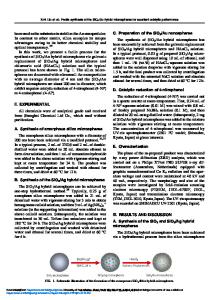Synthesis and catalytic practicality of CeO 2 nanoparticle: an excellent heterogenous candidate for 4-nitrophenol reduct
- PDF / 2,641,162 Bytes
- 13 Pages / 595.276 x 790.866 pts Page_size
- 22 Downloads / 287 Views
ORIGINAL ARTICLE
Synthesis and catalytic practicality of CeO2 nanoparticle: an excellent heterogenous candidate for 4‑nitrophenol reduction Dadu Mal1 · Aamna Balouch1,2 · Sirajuddin3 · Abdullah1 · Ali Muhammad Mahar1 · Abdul Hameed Pato1 · Sagar Kumar1 · Shanker Lal1 · Aneel Kumar1 Received: 1 March 2020 / Accepted: 30 May 2020 © King Abdulaziz City for Science and Technology 2020
Abstract The present study is based on a synthesis of facile, cheaper, well homogenized and highly stable Cerium Oxide nanostructures via chemical precipitation method. The synthesized nanoceria was subjected under different characterization tools. The UV–visible and FTIR study profile initially confirm the formation and existing functionalities in nanoceria. The XRD, SEM techniques were exploited the crystalline and untwined combined form rhombohedron shaped C eO2 nanoparticles respectively. While zeta sizer measurements explained well arranged, mono-dispersity, size and charge over the surface of nanoceria, which was calculated to be 17 nm with a desirable charge of + 6.37 mV. Finally, the well-prepared nanoceria nanoparticles were successfully applied as effective heterogeneous catalyst for 4-nitrophenol reduction. Under optimized conditions the nanoceria exhibited enhanced activity for 99% reduction of 4-NP within 60 s reaction time under greener microwave irradiation. Keywords Cerium oxide · Chemical precipitation · 4-nitrophenol
Introduction Currently, cerium has been paid great attention to the researchers due to its appreciated applications in engineering and technology. Furthermore, Cerium is very reactive with atmospheric oxygen and readily form a metal oxide with varying composition and known as ceria. In bulk, Cerium oxide has two form having different oxidation states (CeO2 and Ce2O3) (Tsai et al. 2008). It is the only rare earth element which shows stable tetravalent oxidation state unlike other members of lanthanide series mainly exist in trivalent oxidation state (Dao et al. 2011). Numerous methods have been attempted for the synthesis of cerium oxide NPs * Aamna Balouch [email protected] 1
National Centre of Excellence in Analytical Chemistry, University of Sindh, Jamshoro 76080, Pakistan
2
Department of Physics Engineering, Faculty of Science and Letters, Istanbul Technical University, Maslak, 34469 Istanbul, Turkey
3
International Centre for Chemical and Biological Sciences, HEJ Research Institute of Chemistry, University of Karachi, Karachi 75270, Pakistan
including precipitation (Pelletier et al. 2010), hydrothermal (Rojas et al. 2012; Alhaji et al. 2019), solvothermal (Zhang et al. 2011,2018), ball milling (Yadav and Srivastava 2012), thermal decomposition (Wang et al. 2002), spray pyrolysis (Demokritou et al. 2013), thermal hydrolysis (Hirano et al. 2000), and sol–gel methods (He et al. 2012; Darroudi et al. 2014a,b). Amongst all co-precipitation is most satisfactory, economical, simple and widely used at laboratory scale level (Farahmandjou et al. 2016).Cerium oxide NPs are widely appl
Data Loading...











